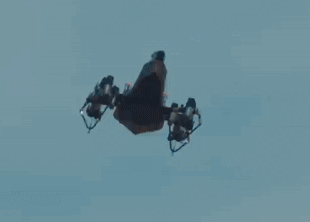The French company Zapata has introduced a high-speed manned drone with ten turbojet engines. She also showed a record of flight tests, during which the drone not only flew in a straight line, but also turned over controllably. The estimated maximum speed of the drone is 250 kilometers per hour, and the payload is 200 kilograms, it is noted on the Zapata website.
In the last few years, dozens of companies in the world have started developing air taxi — multicopters (usually electric) designed to transport one or more people in autonomous mode in or near a city. Not so long ago, devices of an adjacent class began to appear, which have not yet received a separate name, but conditionally they can be called manned drones. These are devices designed for one person, they use an open body and manual control, and most often they are not designed for quiet movement, but for fast flights and races. Among such projects, we can single out the developments of Alauda Aeronautics , Jetson and Drone Champions AG, but the latter, apparently, has curtailed the project.
Zapata, known for its jet hoverboards, introduced a similar JetRacer device with a significant difference — it uses turbojet engines instead of propellers. In general, the drone is built according to a similar scheme: an open pilot's seat with controls is located in the center, and two engine blocks are installed on four sides. Two more engines are located in the center on the sides, next to the cockpit.
The company notes that all engines have spare control units, and also that the drone will be able to continue the flight, even if two out of ten engines failed at once. The device is equipped with a stabilization system and cornering assistance. According to calculations, the JetRacer's speed can reach 250 kilometers per hour, and the maximum altitude is three kilometers.
So far, the company has not achieved these values in practice, but it has already tested the drone with a manned flight. During the tests, the founder of the company Franky Zapata (Franky Zapata) showed both basic maneuvers, such as takeoff, landing, horizontal flight and U-turns, and an atypical coup on the spot for such machines.
As applications for the drone, the company considers both entertainment and demonstration flights, as well as military applications, for example, for a flight between a ship and the shore.
Despite the fact that turbojet engines in drones are rare, this is not the first device with such a source of motion. Last year we talked about a relatively small unmanned drone with four rotary turbojet engines.
Grigory Kopiev

